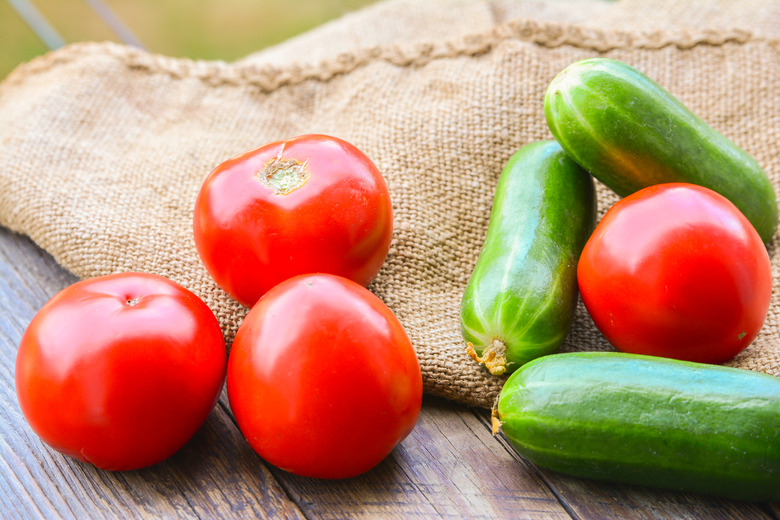Can Cucumbers And Tomatoes Be Grown Together?
In a small home garden, space is often at a premium. You may find yourself crowding together plants or allowing them to mingle with their neighbors just to fit them all in. Sometimes it can be difficult to balance the needs and match the effects of two plants on each other. However, if you're looking for the ultimate companion plants, annual cucumbers (Cucumis sativus) and tomatoes (Lycopersicon esculentum, USDA zones 10-11) grow quite well together.
Find out why cucumbers and tomatoes grow so well together, and how to implement them seamlessly into your home garden.
Compatibility for Companion Planting
Compatibility for Companion Planting
Companion planting is a gardening term for growing plants in close proximity. Ideally, the plants provide each other with some sort of benefit: One repels a common pest of the other, perhaps, or a taller plant provides shade to a shorter plant that can't tolerate as much sun. At a minimum, the two plants should be compatible and not interfere with each other.
Cucumbers are considered compatible with tomatoes because their growth habits are similar enough to be complementary, and so are their aversions (both tomatoes and cucumbers dislike growing near potatoes).
Needs of Tomatoes and Cucumbers
Needs of Tomatoes and Cucumbers
Tomatoes and cucumbers share many of the same basic needs. Cucumbers require 50 to 70 days to reach maturity, while tomatoes need 55 to 105 days, depending on the variety. Both are warm-season crops that require good drainage and a soil pH of 5.8 to 6.5. Because both require deep watering and a consistent supply of water to help fruit develop properly, having the two share space in the garden makes sense.
Placement for Tomatoes and Cucumbers
Placement for Tomatoes and Cucumbers
Depending on type, both tomatoes and cucumbers have either a bush or vining growth pattern, so you can combine them in a couple of different ways. When planting your tomatoes and cucumbers together, one option is to let the cucumber vines grow along the ground in the space between tomato plants. The cucumbers' aggressive growth habit and broad leaves will help crowd out weeds, limiting competition. You can also plant a vining tomato plant, for example, that grows on a vertical support, while planting several bush-type cucumbers around the tomato plant.
Alternatively, you can train cucumber vines onto the same supports you use for tomatoes. This mingling of plants is called diversified planting, which is a strategy to make it harder for insect pests to find and damage specific crops. Because either crop can develop mold problems under moist conditions and crowding, allow plenty of space for air to circulate between plants.
Cucumbers' and Tomatoes' Shared Diseases
When growing these two crops together, you must consider the potential for disease. While cucumber mosaic virus does affect both tomatoes and cucumbers, the disease is not limited to these two crops — it affects more than 40 families of plants. Phytophthora blight and root rot are more serious issues as these disease pathogens can ravage both cucumbers and tomatoes. Plants can be treated with commercial fungicides as a preventive measure, but it's better to just use good cultivation practices.
Rotate crops to prevent infection, leaving a period of three years between repeat uses of a space for cucurbit crops (cucumbers, squashes and pumpkins) and solanaceous crops (tomatoes, potatoes, eggplants and peppers). When you pair tomatoes and cucumbers in the same space in the same year, that effectively gives you double use of one susceptible area before you have to rotate in a crop from a different plant family.
